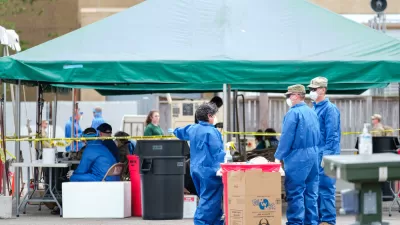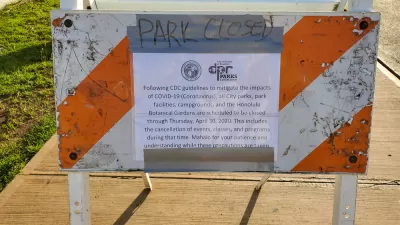The Peace Garden State is one of a handful of rural states never to have issued a stay-at-home order, yet it is number three in coronavirus testing per capita and number one in contact tracing, two of the four tools needed to contain COVID-19.

"On a per-capita basis, North Dakota is third in the nation in testing, effectively tied with Massachusetts and trailing only Rhode Island and New York," write Ben White and Renuka Rayasam for the POLITICO Nightly: Coronavirus Special Edition of May 7, based on an email by healthcare reporter, Dan Goldberg. The Peace Garden State is one of eight states that was never fully shut down.
On May 6, North Dakota’s Republican Gov. Doug Burgum reported that 2,211 tests were processed, the highest daily total yet, write White and Rayasam. The ratio of positive cases to total tests administered, known as the test-positivity rate, on May 8 was one of the nation's lowest, 3.6%, according to the North Dakota Department of Health, a level close to that of South Korea.
A high positive rate, like the 15% for the U.S. (calculated from the COVID Tracking Project on May 8), is not a good sign. However, it is sign of progress in that is down from the 20% reported by the post referenced below.
“If you have a very high positive rate, it means that there are probably a good number of people out there who have the disease who you haven’t tested,” said Ashish Jha, the director of the Harvard Global Health Institute in a post last month on their new report calling for tripling the amount of testing to 500,000 daily.
“You want to drive the positive rate down, because the fundamental element of keeping our economy open is making sure you’re identifying as many infected people as possible and isolating them.”
Harvard almost doubles their minimum testing quota
The Harvard Global Health Institute partnered with NPR and released an updated version of their model of projected state testing targets on May 7, "looking at how many tests we think each state should be ready to perform by May 15."
The numbers are sobering: Overall, our need for testing has only increased over the past weeks. Fewer than a dozen states have gotten ahead of this virus.
Nationwide, our estimates show that the U.S. will need to be doing at least 900,000 tests daily by May 15.
"Harvard's testing estimate increased, says Ashish Jha, director of the Global Health Institute, because the latest modeling shows that the outbreak in the United States is worse than projected earlier," according to NPR (a 4-minute listen plus interactive graphics for individual state minimum testing requirements).
Contact tracing champion
"NPR reported [originally published on April 28] that North Dakota -- population 762,000 -- is the only state to meet an estimated need of 30 contact tracers per 100,000 people," reported Jack Dura for The Bismarck Tribune on May 3 (source article).
North Dakota contact tracing administrator Vern Dosch said 352 people have been trained on the techniques of finding people who have been close to someone with COVID-19.
"Robust contact tracing" is one of eight priorities [pdf] of the governor's "ND Smart Restart" for rebuilding economic activity.
The other person in charge of contact tracing is Brigadier General Robert Schulte of the North Dakota National Guard. "Schulte said each infected person in North Dakota has, on average, six contacts," reports Goldberg for POLITICO.
Tracing and testing those contacts, and keeping them from infecting others before they display symptoms, helps explain why North Dakota, which never issued a stay-at-home order, still has one of the lowest positive test rates in the nation.
Reopening North Dakota
Gov. Burgham had either shut down or restricted access to nonessential businesses including restaurants and bars, since March 20. The Washington Post's guide, "Where states are reopening after America’s shutdown," examines every state and "is tracking the extent of this reopening alongside the rate of new infections and will update this page frequently." Here's the status for North Dakota:
On April 29, the governor issued an order that suggested many of the closed businesses — including bars, restaurants and salons — could reopen beginning May 1. Movie theaters can reopen at 20 percent capacity. Gyms can reopen with additional restrictions. Campgrounds and marinas will reopen May 9.
As for the remaining two containment strategies, isolating people who test positive for COVID-19 and quarantining their contacts found by the tracers, Gov. Burgum has issued three executive orders to that effect, the most recent one [pdf] signed on April 21.
Related in Planetizen:
-
President Trump's Plan to Reopen the Economy Rests with States, April 20, 2020
FULL STORY: Contact tracing puts North Dakota at forefront

Study: Maui’s Plan to Convert Vacation Rentals to Long-Term Housing Could Cause Nearly $1 Billion Economic Loss
The plan would reduce visitor accommodation by 25,% resulting in 1,900 jobs lost.

Alabama: Trump Terminates Settlements for Black Communities Harmed By Raw Sewage
Trump deemed the landmark civil rights agreement “illegal DEI and environmental justice policy.”

Why Should We Subsidize Public Transportation?
Many public transit agencies face financial stress due to rising costs, declining fare revenue, and declining subsidies. Transit advocates must provide a strong business case for increasing public transit funding.

Paris Bike Boom Leads to Steep Drop in Air Pollution
The French city’s air quality has improved dramatically in the past 20 years, coinciding with a growth in cycling.

Why Housing Costs More to Build in California Than in Texas
Hard costs like labor and materials combined with ‘soft’ costs such as permitting make building in the San Francisco Bay Area almost three times as costly as in Texas cities.

San Diego County Sees a Rise in Urban Coyotes
San Diego County experiences a rise in urban coyotes, as sightings become prevalent throughout its urban neighbourhoods and surrounding areas.
Urban Design for Planners 1: Software Tools
This six-course series explores essential urban design concepts using open source software and equips planners with the tools they need to participate fully in the urban design process.
Planning for Universal Design
Learn the tools for implementing Universal Design in planning regulations.
Smith Gee Studio
Alamo Area Metropolitan Planning Organization
City of Santa Clarita
Institute for Housing and Urban Development Studies (IHS)
City of Grandview
Harvard GSD Executive Education
Toledo-Lucas County Plan Commissions
Salt Lake City
NYU Wagner Graduate School of Public Service





























